Traditionally jewellery has played a muted role in men’s fashion; however, change is in the air. 
For example, men’s wedding rings are typically plain compared with that of their counterparts.
Watches with a ‘minimalist’ design featuring straightforward displays are popular and if a man is feeling particularly adventurous, perhaps he’ll wear a simple silver bracelet or chain.
In recent years there’s been a clear shift away from this ‘quiet’ approach to jewellery. The cause of this shift is up for debate.
Some would suggest that there has been a constant push for ‘genderless’ fashion, matching popular political discourse around ‘gender identity’.
Others may say that this is merely fashion working in a cyclical nature, where everything that was once old is eventually new again.
Whatever the cause, one thing is clear – male celebrities and trendsetters are increasingly pushing the boundaries.
When it comes to jewellery, men are wearing increasingly more striking pieces, including Baroque earrings, ornate brooches, diamonds and gemstones - and more recently, pearls.
“Pearls for men have been everywhere lately — and we think they’re here to stay,” writes Lia McGarrigle of Highsnobiety.
“That is not only because the number of brands offering pearls has skyrocketed, but also because the campaign for turning a gemstone previously known for being worn by grandmothers into a staple for all genders has some serious ‘celeb’ firepower.”
She adds: ‘Pearls are such a classic piece that they've transcended age, style, and now gender.”
Goddess of Love
Pearls have a fascinating history. For example, few people are aware that Roman emperor Julius Caesar decreed that pearls could only be worn by members of the ruling class.
In Ancient Rome, pearls were viewed as more valuable than diamonds, and were adored as a representation of wealth and power.
Caesar was particularly enamoured with pearls – it’s said he believed he was an ancestor of the goddess Venus.
For many Romans, the Goddess of Love was believed to have been the source of pearls.
The emperor also gifted a mistress the legendary ‘Servilia’s pearl’ – a black pearl which reportedly cost the modern equivalent of $US1.5 billion to acquire!
Caesar is far from the only famous historical figure to adore pearls. Cleopatra, the ruler of Egypt, once dissolved a pearl in vinegar and drank the mixture.
YongZheng Emperor was the fifth ruler of the Qing dynasty in Imperial China. His royal portrait shows him wearing formal regal attire and his court pearl necklace, known as the chaozhu.
Such court necklaces typically consisted of more than 100 flawless pearls with a bead of a different colour or material, called the fotou or ‘Buddha’s head’, placed between groups of 27.
Indeed, if diamonds are a girl’s best friend, then perhaps historically pearls belong to the boys, posits Nick Haramis of the New York Times.
“The history of men in pearl necklaces — a perilous internet search, if ever there was one — can be traced to the early 16th century, during the Mughal Empire in India, when long strands could be seen on the emperor Babur and his male descendants,” he explains.
“In Europe, Henry VIII wore clothes embroidered with them during his reign as the king of England in the first half of the 1500s. A mourning costume presented to Captain Cook in 1774 during one of his voyages to Tahiti featured a mask and breastplate made of mother-of-pearl.”
He adds: “For each of them, ornamentation suggested clout.”
Cycles and celebrations
It’s difficult to pinpoint exactly when pearls fell out of favour with male consumers.
As well as a symbol of power and wealth, pearls were also once associated with adventure, given the seafaring spirit it takes to acquire them naturally. 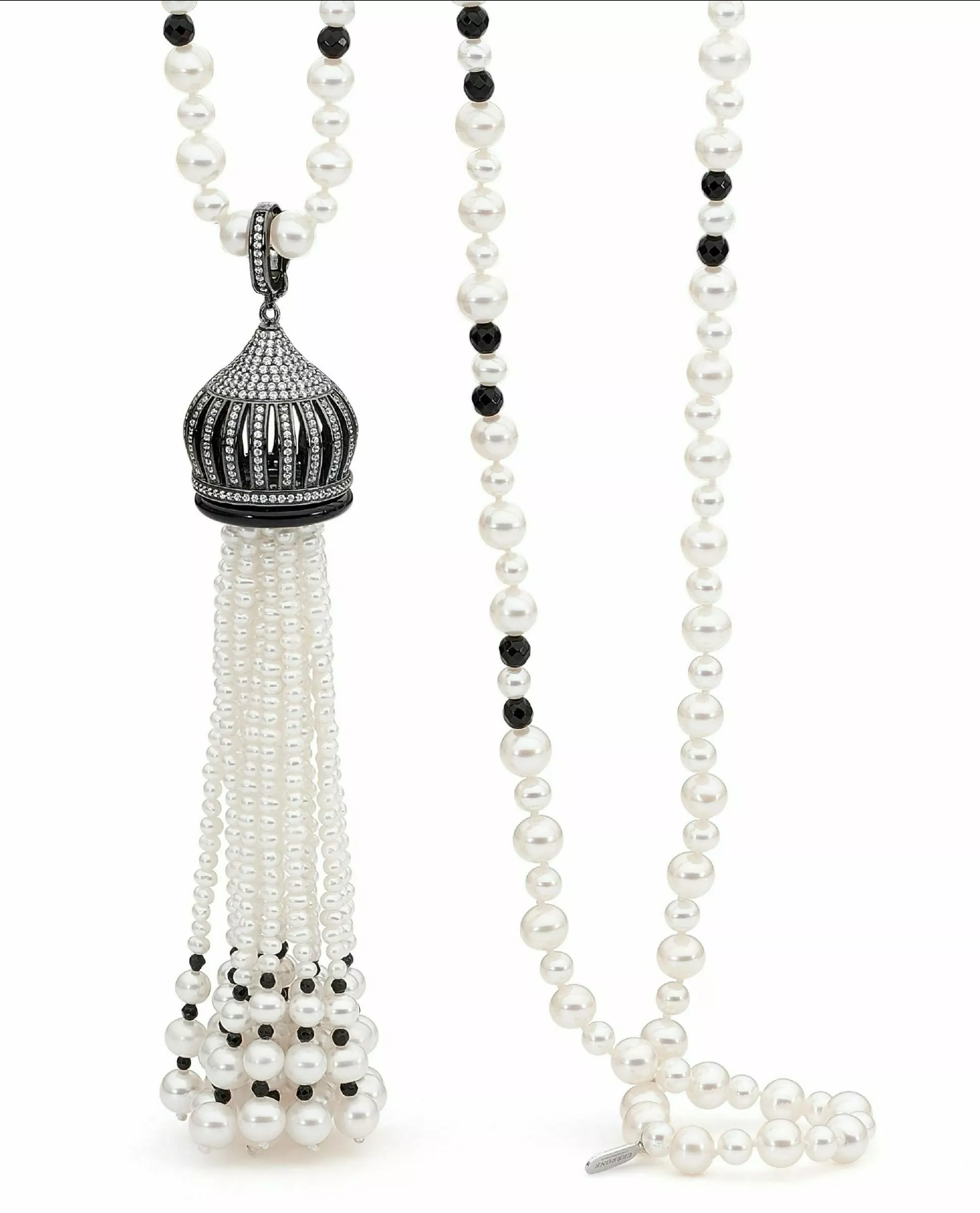
In 1888, Japanese entrepreneur Mikimoto Kokichi obtained a loan to begin his first pearl oyster farm.
Following five years of trials, Kokichi – facing bankruptcy and humiliation – successfully seeded an oyster with mother of pearl.
From there he created the first batch of hemispherical cultured pearls, launching Japan’s iconic cultured pearl industry.
This led to the widespread availability of pearl jewellery and perhaps for many, detracted from the ‘natural wonder’ and excitement of pearls.
Another explanation was the focus of marketing campaigns driven by the popularity of iconic figures such as Audrey Hepburn, Coco Chanel and Jacqueline Kennedy.
As a company, Mikimoto will soon celebrate its 130th anniversary.
According to US chief operating officer Kentaro Nishimura, pearls remain “essential jewellery for everyday life for all genders and generations.”
“The momentum at which pearls have increased in popularity is incredible and is in large part due to their timelessness and elegance,” he tells JCK Online.
“We are looking forward to sharing the beauty and history of Mikimoto and its high-quality pearls with the world.”
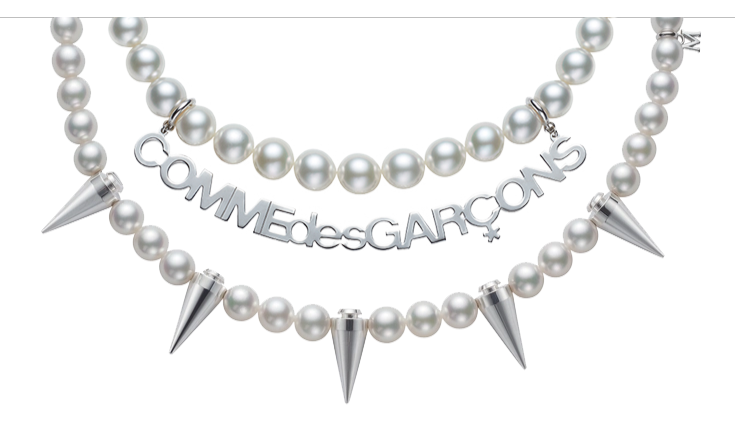 |
| From top: Mikimoto |
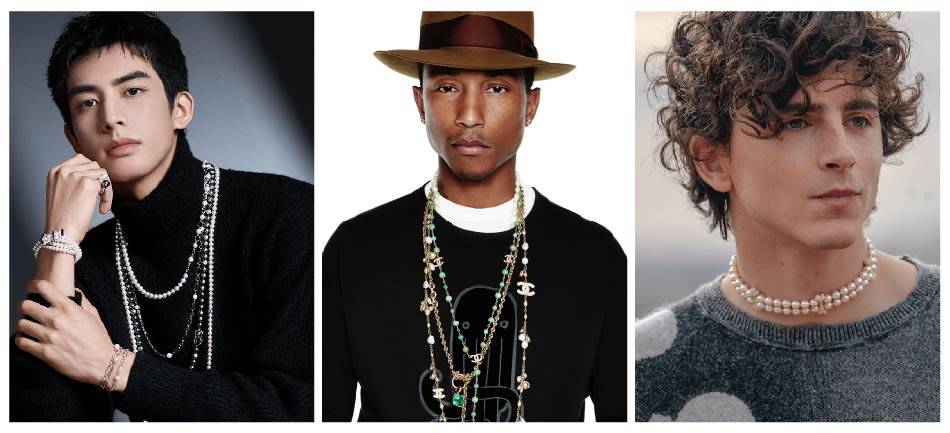 |
| L to R: Song Weilong x Mikimoto 2023, Pharrell Williams 2014, Timothée Chalamet 2022 |
Styles and styles
In February, one British heartthrob dominated Australian media headlines as ‘Harry Styles mania’ swept Australia’s capital cities.
Formerly of One Direction and X Factor fame, Styles’ solo tour featured sellout performances in Melbourne, Sydney, Perth and the Gold Coast.
Despite still being in his 20s, Styles has been a fashion icon for much of the past decade. 
If any single figure were to be created with the resurgence of pearls in the male jewellery sphere, it would be the award-winning singer and songwriter.
“A pearl necklace on a guy? Standard practice. And we can largely pay thanks to Harry Styles for this transmutation,” writes Murray Clark of British GQ.
“Who else could've facilitated the conservative fidget spinner of detached, moneyed housewives into a grail item proper? Nobody! That's who!
“In his Gucci-sponsored deep space showman state, the singer has massaged the boundaries of menswear, womenswear and everything in between to become a style icon.”
The rise to prominence for Styles has coincided with his shift away from traditional masculine clothing and the decision to embrace more ‘genderless’ design.
It’s a decidedly humorous contradiction, given the ‘enthusiasm’ he generates from large swathes of the opposite sex, evidenced by fans fainting at the sight of the singer on stage.
Pearls have been at the centre of his look for the majority of this ascent – beginning with his appearance at the 2019 Met Gala when he sported a single pearl earring.
This continued in late 2019 and early 2020 with a flurry of television appearances in the US and UK – each time showcasing pearl jewellery.
“Over the course of the past decade, Harry Styles has transformed himself from a boy band heartthrob into an international renaissance man with an eye for fashion,” writes Eliza Huber for Refinery29.
“The addition of traditionally feminine jewellery into the singer’s repertoire doesn’t come as much of a surprise given the number of gender-bending looks that he’s donned recently.
“The hype around his jewellery arrives at a time when gender-fluid fashion is gaining mass-market appeal.”
Influencers adopting pearls
Styles may be a key figure in the ‘pearl jewellery for men’ army but he’s far from the only soldier.
US actor Timothée Chalamet commonly attends major events in ‘gender bending’ outfits detailed with pearls.
Musicians such as A$AP Rocky, Pharrell Williams, Jaden Smith, Tyler the Creator, and Shawn Mendes are all known to sport these aquatic rarities.
“The latest advocate of pearl jewellery domination is none other than Timothée Chalamet,” writes McGarrigle.
“This is far from being the first time that we've seen Chalamet venture into wearing pearl jewellery, in fact, the actor has become a leading face in the pearl resurgence which has been bubbling away.”
She continues: “Of course, men wearing pearls have attracted some ‘haters’ that argue the trend is played out, but we beg to differ. The gemstone has remained ubiquitous in women's jewellery for decades now — everyone from that fashion week influencer you follow to your mother likely has a pair knocking around.”
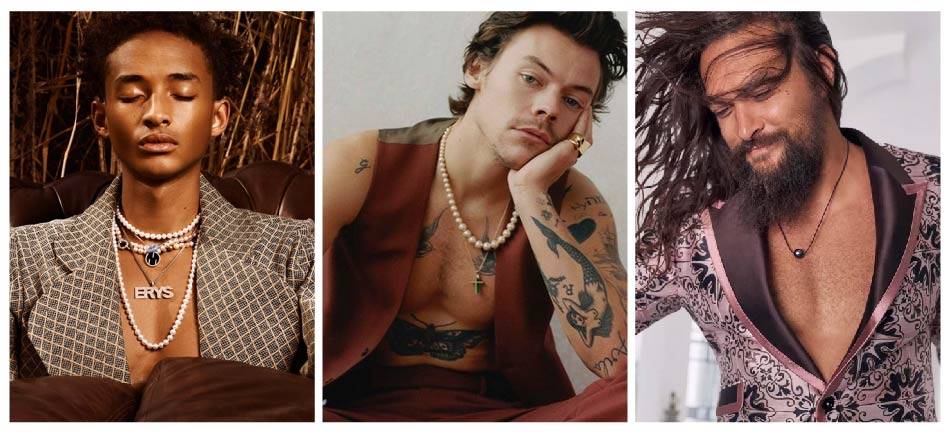 |
| L to R: Jaden Smith 2020, Harry Styles 2020, Jason Mamoa 2020 |
Compelling data
It’s all well and good that a few famous faces are endorsing pearl jewellery; however, trends are ultimately determined by retail data and not fame.
Are there any numbers to support the idea that this is anything more than a passing celebrity fad?
The answer to that question is ‘yes’.
According to a report from fashion technology company Lyst, men purchasing jewellery increased by 150 per cent in 2020.
Searches for ‘men's pearls’ increased by 17 per cent and searches for specific pearl styles such as anklets and earrings respectively increased by 67 and 25 per cent respectively.
More recently, online marketplace TheRealReal published its 2023 edition of the Luxury Consignment Report and found that “demand for pre-owned jewellery continues to climb.”
“Unique personal pieces like colour gemstones, vintage-inspired brooches and pearls lead the way, making it clear shoppers see the value in timeless styles, even when they’re not new.”
Demand for pearls has increased specifically and in Q3 and Q4, interest in pearls (increased 115 per cent) outpaced diamonds (increased 50 per cent).
Examining Q4 2021 v Q4 2022 searches, demand for pearl bracelets (increased 50 per cent) also significantly outpaced interest in diamond bracelets.
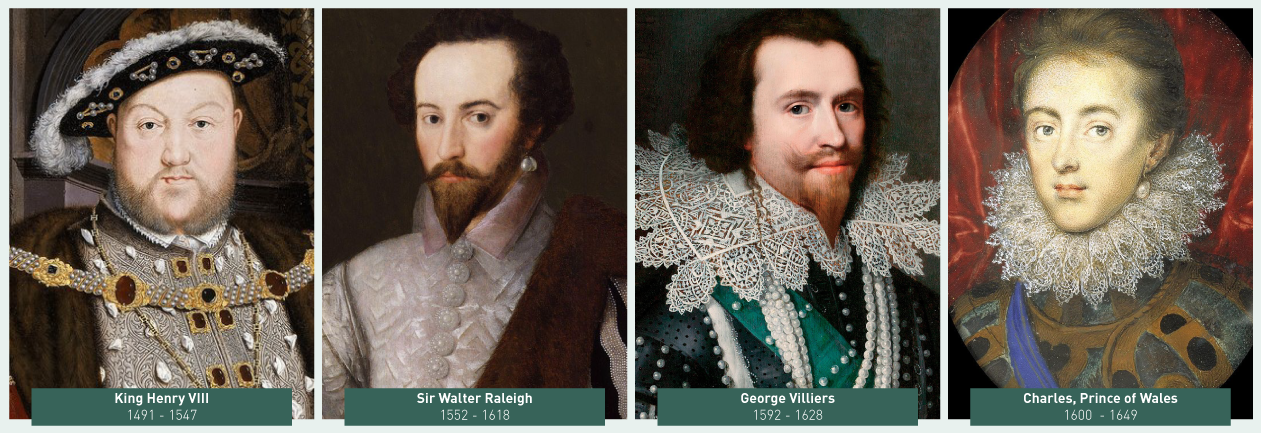
Adored by young consumers
Market research firm MVEye recently completed a study alongside the Cultured Pearl Association, surveying more than 1,000 fine jewellery consumers aged between 25–55.
Market research firm MVEye recently completed a study alongside the Cultured Pearl Association, surveying more than 1,000 fine jewellery consumers aged between 25–55.
The report found 42 per cent of millennials are very likely to request pearl jewellery, as compared with only 19 per cent of 46-to-55-year-olds.
Some 24 per cent of millennials are ‘very likely’ to purchase pearl jewellery for themselves compared with 10 per cent of 46-to-55-year-olds.
Additionally, 47 per cent are very likely to purchase pearls as a gift compared with 16 per cent of 46-to-55 ear olds.
Another major finding was that 36 per cent of millennials will consider a pearl as the centrestone in an engagement ring, and a further 40 per cent said they might ‘give it a go.’
“Pearls are nature’s perfect gemstone - natural, renewable, sustainable and growing them enhances the ocean environment,” Marty Hurwitz of MVEye tells Forbes.
“There is tremendous interest in pearls among consumers. Jewellery retailers need to catch up.”
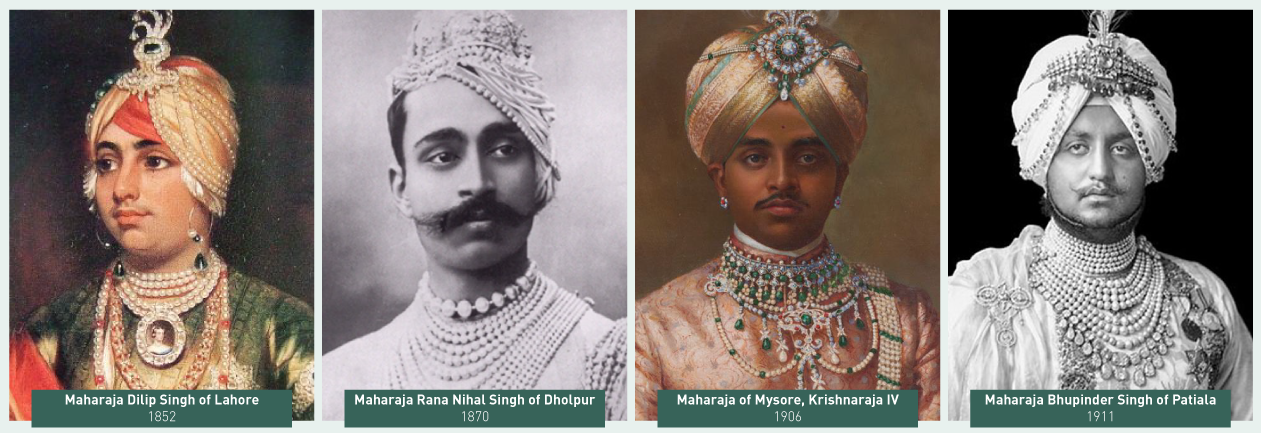
Timeless appeal
McGarrigle echoes this sentiment and says that for jewellery retailers, ignoring the trending popularity of pearls now risks irrelevance in the future.
“Men wearing pearls isn't a fad, it's an example of how the jewellery world is finally opening up to the genderless style,” she says.
“While pearls are currently reserved for the most fashion-forward among us, in a few years, pearl necklaces are about to be as commonplace as chains are for men. Watch this space.”
Whether or not her brazen prediction will prove accurate remains to be seen, however; one thing is clear – pearls have timeless appeal.
Pearls have been admired by societies across the world for thousands of years and they’ve tended to symbolise different meanings to different cultures – from strength to good fortune, perfection, wisdom and beauty.
Legendary fashion designer Marc Jacobs even describes his favourite strand of pearls as his “good luck charm.”
Whether it’s this fashion cycle or the next,